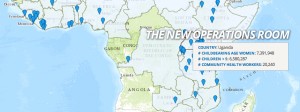Phase 2 of the Operations Room is Up and Running!

We’re extremely proud to announce the rollout of Phase 2 of our Operations Room! The One Million Community Health Workers (1mCHW) Campaign has been developing Phase 2 over the past three months with Direct Relief and ESRI.
The goal of the Operations Room is to refocus efforts on scaling-up community health workers (CHWs) for MDG achievement and universal health coverage (UHC). By using a geographic approach, we intend to empower governments and partners with information on their CHW landscapes. Before this, there was no comprehensive view of CHW programs across sub-Saharan Africa—our dashboard is one of the first to give such a wide-scale view of community health worker programs. Our Operations Room Utility Report aggregated survey responses and highlighted the functionality of the Operations Room as a hub for sharing and gathering useful information on performance indicators, best practices from around the globe, and innovation in the field.
The Campaign has been working hard on developing Phase 2 of the Operations Room. Phase 2 boasts improved user experience, interactive map development, and direct data download. Survey data on CHWs is linked to country and even district-specific demographic and health indicator datasets. This granular data allows governments and organizations more insight into those areas that may have severe health burdens but limited health workers.
The first tool to be available during Phase 2 is the Data Exploration Tool, which is live on our website. This function allows users to explore country trends in CHW location and service provision, as well as individual organizations’ program components. The Organization Comparison Tool will allow for users to visually compare organizations, within the same country and across the entire continent, to contrast programs and draw conclusions in best practices. Finally, the Issue Comparison Tool enables users to compare different health issues in the same geographical location and to assess the need for CHW programs in particular locations.

Comments are closed